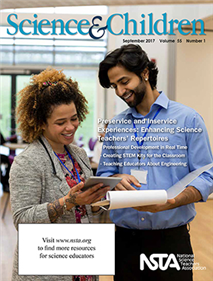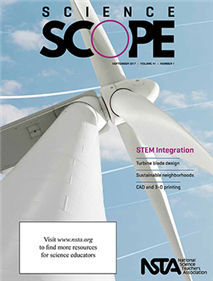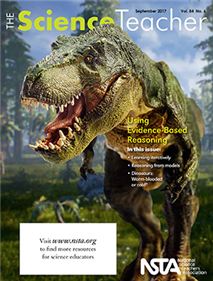All Resources
Journal Article
Professional Development in Real Time
Teachers learn from a live lesson on binary code....
Journal Article
Creating STEM Kits for the Classroom
Preservice teachers design developmentally appropriate science lessons and gain STEM experience....
Journal Article
Integrating Science Methods With Professional Development
How “third space” courses benefit preservice and inservice teachers...
Journal Article
Preservice teachers and science majors host STEM family nights....
Journal Article
Discussing Science in Professional Learning Communities
Teachers collaborate to transform next generation science teaching and learning....
Journal Article
A university-nonprofit-school partnership aims to raise environmental awareness....
Journal Article
Editor's Note: Learning and Teaching (and Vice Versa)
Science and Children’s editor shares thoughts regarding the current issue....
Journal Article
The Early Years: Experiencing Inquiry
This column discusses resources and science topics related to students in grades preK to 2. This month’s issue shows how teachers can experience physical science inquiry with colleagues while investigating properties of matter using the EER cycle a...
Journal Article
This column focuses on promoting learning through assessment. This month’s issue discusses the formative assessment probe “Can You Pick It up With a Magnet?” which is designed to find out what types of materials students think interact with mag...
Journal Article
Teaching Through Trade Books: The Tool and Eye
This column includes activities inspired by children’s literature. In this month’s issue students explore animal adaptations through books that show how body structures assist in survival or how animals use objects in their environment to meet th...
Journal Article
The Poetry of Science: What Do Scientists Do?
Building literacy in playful, meaningful ways. Students use poetry to learn about Rachel Carson. ...
Journal Article
Science 101: Can Electromagnetic Waves Affect Emotions?
This column provides background science information for elementary teachers. This month’s issue discusses electromagnetic waves....
Journal Article
Science 102: Area of a Circle Conundrum
This column shares exercises to challenge content knowledge. This month's issue presents a new challenge and answers the Match Magic challenge from last month....
Journal Article
Engineering Encounters: Teaching Educators About Engineering
This column presents ideas and techniques to enhance your science teaching. This month's issue describes preservice elementary teachers learning engineering principles from engineers....
Journal Article
Learn to design homes that are both energy efficient and affordable....
Journal Article
Teaching Thermal Energy Concepts in a Middle School Mathematics-Infused Science Curriculum
Explore thermal energy transfer while reinforcing students’ graphing skills....
Journal Article
Exploring the Engineering Design Process Through Computer-Aided Design and 3-D Printing
Build and race soap box derby cars as part of a unit on force and motion....
Journal Article
Use motion-triggered wildlife cameras to study mammals in your neighborhood....
Journal Article
Teacher's Toolkit: STEM Career Bingo
This column provides how-to strategies and practical advice for the science teacher. This month’s issue describes STEM Career Bingo, which is an activity that raises student awareness of career opportunities in STEM fields. During the activity, stu...
Journal Article
This column shares how teachers use technology for assessment, student learning, or classroom management. This month's column describes an activity for eighth-grade classrooms that addresses energy transformation and renewable energy. This activity a...
Journal Article
From the Editor's Desk: STEM Integration: A Tall Order
Science Scope’s editor shares thoughts regarding the current issue....
Journal Article
Citizen Science: Navigate Classroom Citizen Science Throughout the School Year with Journey North
This column highlights formal and informal science research projects that students can join and contribute to by gathering and sharing data. Journey North invites students to serve as scientists while they construct a greater understanding of season...
Journal Article
Disequilibrium: Colorful Covalent Bonds
This column shows how to use discrepant events to confront misconceptions. This month’s discrepant event is a colorful way to help students visualize changes in molecular bonds and explore the concept of surface tension. The activity provides stud...
Journal Article
Listserv Roundup: Add More STEAM to Your Classes
This column shares recent conversations taken from the NSTA listserv community about current science education topics. Add STEAM to your classroom by using STEAM-based icebreakers and team-building activities on the first day of school. You can also ...
Journal Article
Science for All: Breaking the Cycle: Thoughts About Building Grit in the Classroom
This column shares strategies for increasing student engagement. Learn how to foster two important skills in students: perseverance and passion to achieve long-term goals....
Journal Article
Teacher to Teacher: Written Assessment in Three Dimensions
This column provides practical advice from your peers. This month’s column will illustrate how you can use the NGSS evidence statements to create a summative assessment, focusing on the question: What are the characteristics of waves, and how can t...
Journal Article
Scope on the Skies: Cassini’s Grand Finale
This column focuses on astronomy throughout the year. This month’s issue discusses the last portion of Cassini's mission....
Journal Article
Analyzing chemical reactions to determine trends in ionization energy and electron affinity....
Journal Article
Editor's Corner: Evidence-Based Reasoning
The Science Teacher’s editor shares thoughts on the current issue....
Journal Article
Science 2.0: Enhancing Google Sheets for the Classroom
This column shares web tools that support learning. This month’s issue focuses on one of the benefits of Google Sheets that sets it apart from similar tools: the add-ons....
Journal Article
Commentary: Reasoning Versus Post-Truth
An opinion piece about how the history of science reminds us of the qualities that support all the practices of science, including evidence-based reasoning....
Journal Article
Focus on Physics: Eight Tips for New (and not so new) Teachers
This column helps teachers build an understanding of physical principles. This month's issue discusses traits and practices that make the difference between loving teaching and enduring teaching....
Journal Article
The Green Room: Exploring Our Public Lands
This column focuses on making your teaching more environmentally friendly. This month's issue discusses the different uses of public lands....
Journal Article
Health Wise: Be Prepared for Opioid Overdoses
This Q&A style column provides up-to-date information on current health topics—helping students (and teachers) make healthy choices. This month’s issue discusses student overdoses related to the national opioid epidemic....





